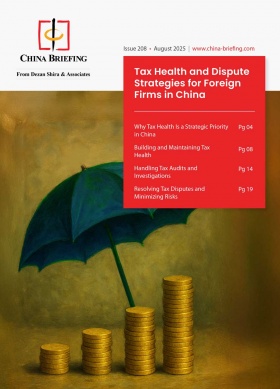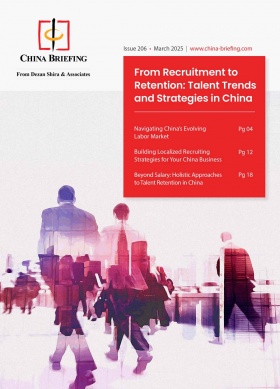Key Regulatory Developments in China’s F&B Sector: Implications for Industry Stakeholders
China’s F&B regulatory developments are reshaping the sector in 2025. New policies strengthen food safety, promote domestic competitiveness, and open high-value segments to foreign players. This article breaks down key changes and their implications for industry stakeholders across dairy, health foods, and cross-border e-commerce.
China’s food and beverage (F&B) sector is undergoing a significant regulatory transformation in 2025, marking a new phase in the government’s efforts to modernize and safeguard the industry. Recent policy and standard updates reflect a strategic push to enhance food safety, boost domestic competitiveness, and improve transparency across the supply chain.
These reforms span multiple fronts, from stricter controls on liquid food transport and revised dairy standards to new recall obligations for cross-border e-commerce, the rollout of digital food labels, and streamlined registration for special medical formula products. Notably, the long-awaited resumption of approvals for imported health foods signals a selective opening of high-value segments to foreign participation.
Taken together, these developments go beyond routine adjustments. They underscore China’s dual priorities: reinforcing consumer trust in food quality and creating a regulatory environment that supports domestic innovation while welcoming targeted foreign investment.
For industry stakeholders, whether local dairy producers, multinational food companies, cross-border e-commerce operators, or health food investors, understanding the scope and implications of these changes is essential to navigating one of the world’s largest and most dynamic consumer markets.
Major regulatory changes affecting China’s F&B sector
Food Safety Law amendments
On September 12, 2025, the Standing Committee of the National People’s Congress (NPC) adopted a significant amendment to China’s Food Safety Law. This marks the most substantial adjustment to the legislation in recent years, reflecting the government’s heightened emphasis on regulatory oversight for high-risk food products and transport processes.
The amendments, mostly summarized in the table below, will come into effect on December 1, 2025. Key regulatory changes focus on bulk transport and infant nutrition products.
| China’s Food Safety Law Amendments | |
| Key changes | Implications |
| For the first time, a dedicated licensing system will govern the bulk road transportation of key liquid foods | Operators engaged in this activity will be required to obtain permits, ensuring that the sector is no longer loosely supervised but instead subject to stringent entry controls. |
| Mandatory requirements for dedicated containers and stricter oversight of transport records | Consignors, consignees, and transport operators are now obliged to inspect cleaning and transport certificates, while the forgery or falsification of such records is explicitly prohibited. These measures are designed to close long-standing loopholes in the supply chain, particularly where contamination risks or poor sanitation practices have been difficult to monitor.
|
| Liquid infant formula milk has been brought under the same registration management system that governs infant formula powder | This means that manufacturers must strictly adhere to registered formulas and processes. By aligning oversight for liquid and powdered forms, regulators aim to strengthen safeguards around infant nutrition—an area of heightened public sensitivity in China. |
Besides, penalties for non-compliance have also been strengthened. Minor violations, where operators fail to rectify deficiencies after receiving warnings, will attract fines ranging from RMB 10,000 (US$1,405) to RMB 100,000 (US$14,055). More serious breaches, including transporting without a permit, falsifying cleaning records, or failing to meet container requirements, may trigger fines of up to RMB 500,000 (US$70,277).
The context driving these changes lies in persistent concerns over the safety of liquid foods during transit. Bulk transport has often been associated with hygiene risks, such as contamination through poorly cleaned tanks or adulteration of products during shipping. With the popularity of liquid milk products and ready-to-consume infant formula increasing in China’s market, the authorities are pre-emptively addressing vulnerabilities that could undermine consumer trust.
As Reuters noted in its reporting, the reforms are as much about risk prevention as they are about market discipline.
New standards for China’s dairy industry
China’s dairy industry has entered a new regulatory phase with the implementation of two updated national standards on September 16, 2025, covering ultra-high-temperature (UHT) sterilized milk and fermented milk products.
These changes are not merely technical adjustments: they are poised to reshape both supply-side dynamics for dairy farmers and product innovation strategies for processors, particularly in high-growth consumer segments such as yogurt.
| New Dairy Standards | |
| Regulation | Implications |
| UHT sterilized milk: The revised standard for UHT sterilized milk eliminates references to the use of reconstituted milk (effectively prohibiting manufacturers from using milk powder as a raw material for China’s ubiquitous shelf-stable milk products). |
|
| Fermented milk (yogurt): The second revision focuses on fermented milk products such as yogurt, a market segment that is both highly profitable and rapidly expanding among China’s health-conscious middle class. |
|
Together, these two standards create a double boost for vertically integrated dairy companies that both farm and process milk: they benefit from stronger upstream demand for raw milk and from expanded downstream opportunities in higher-margin fermented products.
Analysts expect that large domestic firms such as Yili and Mengniu, which already dominate the sector, will be best positioned to leverage these changes. Smaller players may face cost pressures, particularly in securing stable supplies of raw milk, but could benefit in the yogurt segment if they are agile in product innovation.
Given China’s yogurt market alone has been projected to surpass RMB 300 billion (US$42.16 billion) in sales by the end of the decade, these regulatory shifts are expected to accelerate the dairy sector’s evolution toward premium, consumer-driven growth.
Cross-border e-commerce (CBEC) food recalls
On September 9, 2025, the State Administration for Market Regulation (SAMR) released a draft policy titled Further Strengthening Recall Oversight for Cross-Border E-Commerce Retail Imported Foods for public comment, with feedback accepted until October 8, 2025.
The draft represents China’s latest step to align CBEC food supervision with domestic food safety rules, addressing long-standing concerns that imported foods sold through e-commerce channels have operated in a regulatory grey zone.
Under the proposed framework, overseas food enterprises will bear primary responsibility for product safety. Companies selling through CBEC channels must immediately halt sales and initiate a recall if safety risks are discovered.
Importantly, foreign manufacturers will be required to appoint a domestic partner to facilitate recall operations, ensuring authorities can act quickly even when the producer is abroad.
The draft also strengthens obligations for platform operators. E-commerce platforms will be expected to enforce compliance by monitoring recalls and suspending violators that fail to carry out their responsibilities. This builds on SAMR’s wider campaign to tighten accountability across digital commerce and prevent unsafe goods from reaching consumers.
Digital labels for pre-packaged foods
China’s updated General Rules for the Labeling of Pre-Packaged Foods (GB 7718-2025), which will take effect in 2026, formally incorporate digital labeling requirements as a complement to traditional labeling. Producers will be permitted (and in some cases encouraged) to use QR codes or similar digital identifiers to provide mandatory product information.
Key points include:
- Consistency with mandatory labeling: Digital labels must display the same legally required information as printed labels, such as product name, ingredients, allergen declarations, shelf life, and nutrition facts.
- Traceability: Changes made to digital labels must be trackable, ensuring authenticity and accountability.
- Advertising restrictions: Digital labels cannot be used for marketing, promotions, or unrelated advertising; they must strictly serve regulatory and consumer information functions.
- Special food categories: Health foods, infant formula, and foods for special medical purposes must align their digital labels precisely with the information filed or registered with SAMR, preventing discrepancies between registered formulas and consumer-facing labels.
The integration of digital labels reflects China’s broader move toward smart regulation, improving transparency while harnessing digital tools for consumer protection.
Guidelines for the registration of special medical use liquid and thickening formula foods
In 2025, China’s SAMR released two new regulatory guidelines: the Registration Guidelines for Special Medical Purpose Liquid Formula Foods and the Registration Guidelines for Special Medical Purpose Thickening Component Formula Foods. These guidelines aim to optimize the registration process, production site inspections, and other regulatory requirements of food for special medical purposes (FSMP).
Key elements include:
- Clearer documentation requirements: The guidelines provide detailed instructions on the materials required for submission, including product formulas, stability data, and clinical application evidence.
- On-site inspections: Authorities have clarified how inspections will be conducted, focusing on production safety, formula authenticity, and compliance with registered processes.
- Efficiency goals: By standardizing requirements and procedures, the guidelines are expected to shorten review and approval cycles, reducing uncertainty for manufacturers.
- Market impact: For foreign and domestic producers of FSMPs—especially thickened formula foods for patients with dysphagia or liquid nutritional products—these guidelines offer greater predictability and transparency in entering the Chinese market.
The new regulatory guidelines refine how producers prepare registration applications under the existing Administrative Measures for Registration of Foods for Special Medical Purpose (hereinafter, the “Administrative Measures”), which typically require extensive technical documentation, including product formula design, stability research, production techniques, and proof of R&D and manufacturing capacity. To reduce duplication, SAMR now allows certain exemptions where products are manufactured on existing, registered FSMP production lines that use equivalent formulas and processes.
In addition, while the Administrative Measures generally mandate on-site inspections and sampling assessments, the new guidelines allow these requirements to be waived if the production line is already certified for comparable FSMP products and demonstrates equivalent manufacturing methods.
Resumption of imported health food approvals
In a development that has drawn wide attention across the industry, China’s State Administration for Market Regulation (SAMR) has resumed the approval of imported health foods, marking the first such authorizations since 2017.
For nearly seven years, the registration pathway (commonly known as the “blue hat” system) had been effectively frozen, with no new foreign products obtaining market entry through registration. The sudden revival in mid-2025, therefore, represents both a regulatory milestone and a strong signal to international manufacturers that China is once again opening the door to carefully vetted foreign entrants.
Details of the first wave of approvals illustrate both the diversity of products and the companies involved:
|
Approved Health Foods |
|||
| Registration No. | Product | Applicant / Origin | Claimed function / Key ingredients |
| 国食健注 J20250001 | Notoginseng & American Ginseng Capsules | Wright Life Pharmaceutical Limited (Hong Kong) | Strengthen immunity |
| 国食健注 J20250002 | Curcumin Tablets (Turmeric Extract) | PT. Helmigs Prima Sejahtera (Indonesia) | Maintain healthy blood lipids; auxiliary protection against chemical liver injury |
| 国食健注 J20250003 | Ganoderma Spore Capsules | Wright Life (Hong Kong) | Strengthen immunity |
| 国食健注 J20250004 | Blueberry & Lutein Capsules | Wright Life (Hong Kong) | Relieve visual fatigue |
| 国食健注 J20250005 | Agaricus blazei & Ganoderma Capsules | Wright Life (Hong Kong) | Strengthen immunity |
The approvals span a mix of functional areas (immunity support, liver protection, and vision health), demonstrating that SAMR is not limiting registrations to a single niche but is instead prepared to advance products across multiple health claims, provided they meet rigorous documentation, ingredient, and inspection requirements.
The significance of this policy shift cannot be overstated. For foreign companies, the registration pathway had long been regarded as opaque, costly, and effectively inaccessible since 2018. Many firms seeking entry into China’s massive health food market turned instead to the filing pathway (limited to vitamins, minerals, and certain nutrient supplements) or to CBEC, both of which offered fewer barriers but also narrower opportunities for long-term brand establishment.
The reopening of the registration channel signals that the Chinese government is willing to once again grant direct market access to foreign players able to demonstrate compliance with its stringent standards.
Industry observers interpret the move as both a clearing of the backlog of applications and a deliberate step to diversify consumer offerings in a market that has been dominated by domestic producers in recent years. The approval of a product from Indonesia alongside those from Hong Kong companies highlights the possibility for a wider geographical spread of foreign entrants moving forward.
Other updates and draft standards
In addition to headline reforms on Food Safety Law, dairy standards, and CBEC recalls, China has also launched a series of technical revisions under its 2025 National Food Safety Standard Legislative Plan (hereinafter, the “plan”).
Released in April 2025 by the National Health Commission (NHC) and SAMR, the plan sets the agenda for revising and introducing dozens of Guobiao (GB) standards across food categories, reflecting the government’s push to modernize its regulatory framework in line with international benchmarks.
Specific deliverables under the plan include, among others:
- Food contact materials (FCMs): New draft standards were circulated in July 2025, tightening requirements for migration limits, residual solvents, and the use of plasticizers such as phthalates in packaging. These measures aim to reduce chemical transfer from packaging into food, an issue highlighted in recent domestic testing campaigns.
- Health food labeling rules: In June 2025, SAMR released an updated draft of the General Rules for Health Food Labeling, clarifying requirements for both outer and inner packaging. The goal is to curb misleading branding and ensure that consumers can more easily identify genuine health foods.
Implications for different stakeholders
The 2025 regulatory shake-up in China’s F&B sector carries distinct implications for various industry participants, reflecting the government’s dual goals of consumer protection and industry development.
- Domestic dairy producers: The updated UHT and fermented milk standards favor vertically integrated domestic companies, creating stronger upstream demand for fresh milk while enabling product innovation in high-margin segments such as yogurt.
- Multinational food and health product companies: The resumption of imported health food approvals signals a renewed opportunity for foreign entrants to establish a foothold in China’s high-value health and functional food markets. Firms that can meet documentation, ingredient, and inspection requirements now have a clear regulatory pathway to compete alongside domestic producers.
- CBEC operators: With stricter recall obligations and increased platform accountability, CBEC sellers must implement robust quality control and rapid-response mechanisms. Non-compliance carries reputational and financial risks, making domestic partnerships for recall operations essential.
- Specialized medical food manufacturers: Streamlined registration for FSMPs, including liquid and thickening formulas, reduces uncertainty and approval timelines, improving market predictability. Companies can now leverage existing certified production lines to minimize duplication of inspections, facilitating faster entry and expansion.
- Consumers and retailers: Across all segments, increased transparency through digital labels, traceability requirements, and stricter transport regulations enhances product safety and information accessibility, fostering consumer confidence and potentially driving demand for higher-quality products.
What to watch next
The evolution of China’s F&B regulatory landscape in 2025 is likely to have cascading effects across compliance, supply chains, and market behavior, making it essential for stakeholders to look beyond headline rules.
One key development is the rollout of digital labeling and traceability systems under GB 7718-2025 in 2026. While the adoption of QR codes and other digital identifiers promises enhanced transparency, the ultimate impact will hinge on the effectiveness of the underlying infrastructure, the accessibility of these systems to consumers, and the ability of regulators to prevent misuse or fraudulent practices. Companies that manage these challenges well may not only satisfy compliance requirements but also cultivate consumer trust and supply chain reliability, turning regulation into a potential competitive advantage.
Parallel to this, the finalization of CBEC recall rules will be closely watched. The draft framework released by SAMR illustrates a more hands-on approach to accountability, emphasizing the responsibility of overseas manufacturers and the necessity of domestic partners to facilitate recalls. How these rules are interpreted and enforced—particularly across different regions and platforms—could materially affect operational strategies for foreign and domestic CBEC operators alike.
Meanwhile, the broader updates anticipated under the National Food Safety Standard Legislative Plan, covering areas such as food contact materials, health food labeling, and product claims, highlight the government’s intention to harmonize domestic standards with international benchmarks. Compliance here will require foresight, especially for packaging and labeling practices, but it also opens opportunities for firms to differentiate products in a market that increasingly prizes safety, transparency, and quality.
The resumption of approvals for imported health foods further signals a strategic recalibration by Chinese regulators. Beyond immediate market access, this shift indicates a selective openness to foreign entrants capable of meeting stringent safety and documentation standards. Observers should track which product categories and geographies are prioritized in subsequent approvals, as this will offer clues about the authorities’ longer-term approach to balancing domestic production with carefully vetted imports.
Finally, these regulatory developments intersect with shifting consumer preferences. Fresh, high-quality dairy, functional fermented products, and health-oriented foods are expected to see heightened demand, creating fertile ground for premiumization and product innovation. How consumers respond, particularly in terms of willingness to pay for quality and traceability, will ultimately determine which companies can translate regulatory compliance into commercial advantage.
Read also:
- New Standards for FSMP Infant Formula in China: Key Compliance Deadlines and Registration Guidance
- How to Stay Compliant with China’s Labeling Requirements for Imported Food
- Exporting Food Products to China: A Step by Step Guide
About Us
China Briefing is one of five regional Asia Briefing publications, supported by Dezan Shira & Associates. For a complimentary subscription to China Briefing’s content products, please click here.
Dezan Shira & Associates assists foreign investors into China and has done so since 1992 through offices in Beijing, Tianjin, Dalian, Qingdao, Shanghai, Hangzhou, Ningbo, Suzhou, Guangzhou, Haikou, Zhongshan, Shenzhen, and Hong Kong. We also have offices in Vietnam, Indonesia, Singapore, United States, Germany, Italy, India, and Dubai (UAE) and partner firms assisting foreign investors in The Philippines, Malaysia, Thailand, Bangladesh, and Australia. For assistance in China, please contact the firm at china@dezshira.com or visit our website at www.dezshira.com.
- Previous Article Why a Global Mindset is Critical for Business Success in China
- Next Article







